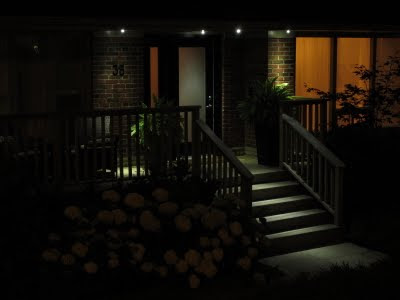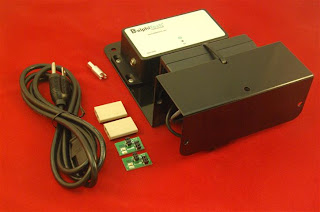Drip edge is a metal flange that is installed under the first row of shingles. Shown below in black below, it serves a few different purposes.
It provides some support to the shingles so that they do not curl down over the years and cause cracking of the shingles and potential water to run down behind the eavestrough. It also creates overlapping of the wooden fascia that can be prone to rot due to water penetration. Another benefit is it can cover any small gaps between the roof deck and the fascia which will prevent animals from seeing an opening which they will then chew at until they are into your attic. Drip edge is also perfect for sealing the ice and water shield to. (Ice and water shield is a water proof membrane that roofing companies install before shingling and helps prevent water leakage in the event of an ice dam.)
Here is a simple metal drip edge: (Picture from Quinby Hardware)
It provides some support to the shingles so that they do not curl down over the years and cause cracking of the shingles and potential water to run down behind the eavestrough. It also creates overlapping of the wooden fascia that can be prone to rot due to water penetration. Another benefit is it can cover any small gaps between the roof deck and the fascia which will prevent animals from seeing an opening which they will then chew at until they are into your attic. Drip edge is also perfect for sealing the ice and water shield to. (Ice and water shield is a water proof membrane that roofing companies install before shingling and helps prevent water leakage in the event of an ice dam.)
Here is a simple metal drip edge: (Picture from Quinby Hardware)
From an eavestroughing standpoint, drip edge is critical to provide you with a roof that will drain water off the roof and into the eavestrough properly. Some roofers that take the short cut of not using a drip edge will often leave the shingles extra-long so that they will sag down into the eavestrough. This will eventually weaken the shingles and hinder proper installation of any new eavestroughs you may be considering after the roof is done.
As seen in the picture below, there is no drip edge which causes the shingles to curl down allowing water to drip behind the eavestrough.
Fortunately, it's simple and inexpensive to do when the roof is being replaced. Roofers can buy drip edge for less than a dollar a foot, is installed quickly and comes in various colours. Unfortunately, it is overlooked most of the time. I recently talked to a home owner who just had 3 roofing quotes and no one mentioned or offered drip edge. It was understandable that he was frustrated that he had to do his own investigating into drip edge to realize the potential benefits.
As seen in the picture below, there is no drip edge which causes the shingles to curl down allowing water to drip behind the eavestrough.
This picture below of a home in Scarborough, shows the obvious gap between the roof deck and the top of the fascia. If an animal gets in there it will enter straight into the attic.
The drip edge should extend about 3 to 4 inches up under the shingles and down 2 inches maximum over the fascia. Any more than 2 inches can interfere with eavestrough and leaf guard installation which may cause you to incur extra costs. One final tip is that the shingles should extend about 1 inch past the drip edge to ensure proper water flow directly into the eavestrough. It is much easier to have drip edge installed in conjunction with a new roof than trying to install it afterwards. It can be done afterwards, if the shingles have not become weak and brittle from curling down. If this is the case, the shingles may break off when trying to install the drip edge so it's best just to install it when doing the roof.
This final picture shows a potential problem with the shingles not hanging about 1 inch past the drip edge. The surface tension of the water will cause the water to travel backwards to the fascia/ eavestrough. The eavestrough is not always tucked up under the drip edge as shown because the eavestrough slowly lowers down to get proper slope. This can cause leaking behind the eavestrough and may require additional flashing work to make sure the water goes where it is supposed to. See our flashing blog post: http://torontoeavestroughing.blogspot.ca/2010/07/flashing-what-is-it.html
Here are some videos we have done up relating to drip edge:
Visit our website at www.eavestrough.ca for more information.





+-+Copy.JPG)






.JPG)








